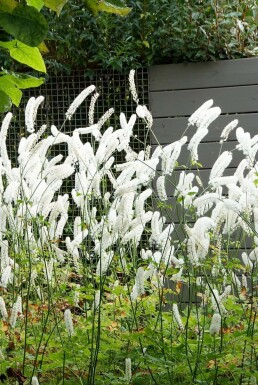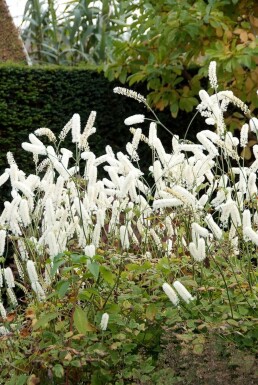

150cm


At Heijnen Plants, we are proud to introduce the Cimicifuga, widely recognized as bugbane, a perennial that brings a touch of stately elegance to any garden. This plant boasts majestic spires of white flowers that gracefully rise above the foliage, adding a vertical accent to your garden's palette. The bugbane's foliage itself is an attraction, presenting a range of hues from deep green to rich purple, depending on the variety. While it is not an evergreen, the seasonal changes in the Cimicifuga's appearance provide a dynamic and evolving display throughout the year.
Cimicifuga, commonly known as bugbane, is a genus of flowering plants that graces gardens with its statuesque presence and strikingly beautiful blooms. Characterized by an upright growth habit, this genus is well-suited for border presentations, group plantings, or as a solitary feature within a garden. With origins tracing back to woodland and meadow regions, Cimicifuga offers a touch of wild elegance to cultivated spaces.
Their distinctive flowers emerge in the latter part of the growing season, from August through October, presenting a display of pristine white that contrasts vividly against the foliage. As the seasons change, the foliage of Cimicifuga transitions through shades of green and purple, offering a dynamic visual experience throughout its growing cycle.
Cimicifuga plants are known for their versatility and aesthetic appeal. Some of their most notable features include:
Embrace the enchanting allure of bugbane, a perennial that brings a touch of majesty to any shade garden with its towering spires of fragrant blooms and striking foliage. Whether creating a serene backdrop or a focal point of architectural interest, these elegant cultivars offer a captivating display from late summer into the fall.
We would like to provide some tips on how to plant and care for a Cimicifuga. By following these tips, you can be sure to enjoy your Cimicifuga for a long time.
For optimal growth, Cimicifuga should be sited in locations that offer sun to partial shade. While it is versatile and can adapt to various soil types, ensuring the soil is well-drained is paramount to the plant's health. The species' preference for moisture implies that soil should retain some water, yet not be waterlogged. Its striking foliage, transitioning from green to purple across the seasons, and the stately white blossoms that emerge in late summer, can be best appreciated in settings that offer a contrast to its dark stems and leaves, such as a lighter backdrop or amongst plants with lighter foliage.
To ensure the successful establishment of Cimicifuga, choose a location that offers either full sun or partial shade and prepare the soil so it is rich and well-draining. While adaptable to various soil types, moisture retention is beneficial to support its upright growth habit and to reach its potential height of 1.5 meters. Planting can be done throughout the growing season, avoiding extremes of heat and frost. Upon planting, water the specimen to settle the soil around the pot-grown roots and continue with consistent moisture, especially during periods of drought, as this species is not drought-resistant.
To ensure the robust growth and vigorous blooming of this species, a balanced fertilization regimen is key. Apply a general-purpose garden fertilizer early in the spring to support the plant's emergence and development. As this plant prefers consistently moist soil, incorporating a slow-release fertilizer can be beneficial, gradually providing nutrients throughout the growing season.
As the species sets buds later in the summer, an additional application of fertilizer can be beneficial to sustain the energy needs for flowering through August to October when the white blossoms make their striking appearance. Always follow the manufacturer's recommended dosage to avoid over-fertilization, which can be detrimental to the plant's health as well as the surrounding ecosystem. After fertilizing, watering the area can help in dissolving the fertilizer, allowing the nutrients to reach the root zone where they are most needed.
Cimicifuga's maintenance is relatively low-key, with limited pruning requirements to keep it thriving. After the blooming period, which graces the autumn months with elegant white spires, one may deadhead the spent flowers to encourage a tidy appearance. However, as the foliage of this deciduous species naturally withers with the onset of winter, extensive pruning is unnecessary. In early spring, as the garden awakens, simply cut back the previous year's stems to ground level to make way for the new season's growth.
Cimicifuga thrives with consistent moisture, particularly when it's establishing its foothold in a garden. This species, while not drought-resistant, has average water needs and should be watered deeply to encourage strong root growth. The soil should remain moist but well-drained; overwatering or waterlogged conditions can be detrimental. During peak growth in the spring and summer, and especially when flower spikes are developing in the late summer to fall, ensure that the soil does not dry out completely. Regular watering during these critical growth phases will promote lush foliage and robust, elegant spires of white blooms.
Cimicifuga thrives in consistently moist soil, so be attentive to its watering needs, especially when grown in containers. Its statuesque spires of blooms provide a vertical element to garden compositions, adding depth and contrast against lower-growing plants. This species is particularly noted for its late-season blooms, which can offer interest during a time when many other plants have finished their display, extending the garden's visual appeal into the late summer and early autumn months.
To propagate and refresh Cimicifuga, division is an effective method. This technique not only stimulates robust new growth but also ensures the vitality of the plant. It is advisable to conduct this process in the cooler periods of spring or autumn, which allows the plant to establish itself without the stress of extreme heat. Carefully lift the Cimicifuga from the soil, gently separate it into smaller sections, and then replant these divisions at the same depth they were originally growing. This will lead to a rejuvenated plant with a vigourous, upright growth habit.
The Cimicifuga, with its elegant, feathery spires of flowers and lush foliage, brings a touch of sophistication to any shade garden. This stately plant thrives in cooler, shaded areas, offering a serene backdrop or dramatic accent. Its statuesque presence is a must-have for garden connoisseurs seeking refined beauty.
